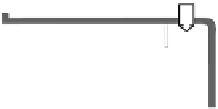Environmental Engineering Reference
In-Depth Information
Geothermal
heating station
Geothermal
heating station
Consumer
Consumer
Production
well
Production
well
Injection
well
Injection
well
Reservior
Reservior
Fig. 10.1
Basic layout of a hydro-geothermal heating station designed to tap hydro-
geothermal heat from the deep underground (see /10-2/, /10-5/)
Drilling technique.
The technique for the drilling of geothermal wells is very simi-
lar to the drilling of oil and gas wells /10-6/. Almost exclusively, the rotary drill-
ing technique is applied. The drilling tool is in most cases a tricone bit. The bit is
rotated via the drill pipe, a steel pipe of much smaller diameter than the bit, by a
rotary table in the floor of the drilling platform. The rock cuttings are transported
to the surface by "drilling fluid", which is pumped down through the drill pipe and
ascends in the annulus between drill pipe and borehole wall. Due to the relatively
large cross sectional area of this annulus high flow rates of the drilling mud are
required to achieve the flow velocities necessary for transporting the rock parti-
cles. During drilling the weight of the drill pipe is hanging on a hook in the tower
of the drilling rig. A string of heavy thick walled large diameter drilling collars
sitting on top of the drilling bit provides the load for the support of the drilling bit.
The weight of the collars and their large diameter stabilise the drilling direction,
and cause a vertical trend of the well. Further stabilisation of the drilling direction
and smoothening of the borehole wall is provided by reamers installed between
the drilling collars and equipped with hard metal cylinders rolling around the
borehole wall /10-1/, /10-2/.
The material of the tricone bits depends on the rock properties, and are selected
according to the experiences made during earlier drilling operations in the corre-
sponding rock type. For more soft rock formations like mudstone, hard metal
cones are sufficient. For hard rock the tricones are equipped with tungsten or even
with diamond particles. The lifetime of the drilling bits range from several de-
cametres to several hundred meters of drilling. The lifetime of the bit is one of the
most important factors for the drilling costs. This is not due to the costs of the bits
















































































































































































































Search WWH ::

Custom Search